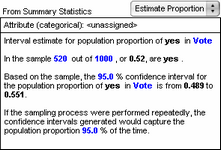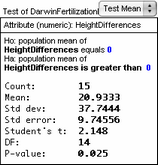|
Fathom Overview > Statistical Objects
When you want Fathom to compute something statistical, you can use a statistical object. There are three kinds of such objects: estimates, tests, and models.
|

|
Use an estimate to compute a confidence interval for some population parameter when all you have is a sample from that data. In the example at right, we have a sample of 1000 voters, and we want to find a confidence interval for the proportion of “yes” votes in the population.
This example shows the verbose mode for statistical objects, in which the results are explained in full sentences that draw attention to the underlying meaning of the numbers. Most statistical objects can be used either with summary statistics, as shown here, or with from which Fathom computes the summary statistics.
|

|
Use a test when you have some data from a sample or an experiment and you want to know whether the result is statistically significant; that is, how different is the result from what you might get by chance and is that difference enough for you to make a decision based on it?
In the example at right, some historical data gathered by Charles Darwin is fodder for a t-test to decide how statistically significant the mean difference in heights between two groups of plants is.
Here Fathom’s nonverbose mode is used so that the output is similar to what you get with a standard statistical package. The final kind of statistical object is a linear model, which can be used to build either a simple or multiple linear regression model.
As good as these statistical objects are at getting the job done when you need some inferential calculations, Fathom only includes the most basic statistical capabilities. You can use to accomplish a wide range of statistical calculation at the cost of some time and with the benefit of getting deeper insight into how statistical inference works.
|

|
(see Collect Measures and Other Results.)
Because statistical objects can be directly driven by formulas (see Use Sliders to Vary Summary Information in a Statistical Object) and can derive their data from collections whose cases are generated randomly, they fit right into Fathom’s simulation environment. You can even from a statistical object (see Collect Results from Statistical Objects) and build distributions of p-values, slopes, confidence intervals, or anything else that appears in a statistical object.
See Work with Statistical Objects.
|





